Flow Patterns and Morphological Changes in a Sandy Meander Bend during a Flood—Spatially and Temporally Intensive ADCP Measurement Approach
Abstract
:1. Introduction
2. Fluvial Geomorphology of Meandering Rivers
3. ADCP—Principles and Applications
4. Study Area
5. Data Collection and Processing
5.1. Data Collection
5.1.1. ADCP and VRS-GNSS Measurements
5.1.2. Recording Water Level
5.2. Data Processing
5.2.1. Flow Field Data Processing
5.2.2. Bathymetric Models and Morphological Change
6. Results and Discussion
7. Conclusions
Acknowledgments
Author Contributions
Conflicts of Interest
References
- Bridge, J.S.; Jarvis, J. Flow and sedimentary processes in the meandering river South Esk, Glen Clova, Scotland. Earth Surf. Process. 1976, 1, 303–336. [Google Scholar] [CrossRef]
- Dietrich, W.E.; Smith, J.D. Influence of the point bar on flow through curved channels. Water Resour. Res. 1983, 19, 1173–1192. [Google Scholar] [CrossRef]
- Ferguson, R.I.; Ashwoth, P.J. Spatial patterns of bedload transport and channel change in braided and near braided rivers. In Dynamics of Gravel-Bed Rivers; Billi, P., Hey, R.D., Thorne, C.R., Tacconi, P., Eds.; Wiley: Chichester, UK, 1993. [Google Scholar]
- Warburton, J.; Davies, T.R.; Mandl, M. A meso-scale field investigation of channel change and floodplain characteristics in an upland braided gravel-bed river, New Zealand. In Braided Rivers; Best, J.L., Bristow, C.S., Eds.; Geological Society Special Publication: London, UK, 1993. [Google Scholar]
- Frothingham, K.M.; Rhoads, B.L. Three-dimensional flow structure and channel change in an asymmetrical compound meander loop, Embarras River, Illinois. Earth Surf. Process. Landf. 2003, 28, 625–644. [Google Scholar] [CrossRef]
- Hooke, R.L.B. Distribution of Sediment Transport and Shear Stress in a Meander Bend. J. Geol. 1975, 83, 543–565. [Google Scholar] [CrossRef]
- Jackson, R.G. Velocity–bed-form–texture patterns of meander bends in the lower Wabash River of Illinois and Indiana. Geol. Soc. Am. Bull. 1975, 86, 1511–1522. [Google Scholar] [CrossRef]
- Bathurst, J.C.; Hey, R.D.; Thorne, C.R. Secondary flow and shear stress at river bends. J. Hydraul. Div. 1979, 105, 1277–1295. [Google Scholar]
- Bluck, B.J. Texture of gravel bars in braided stream. In Gravel-Bed Rivers; Hey, R.D., Bathurst, J.C., Thorne, C.R., Eds.; Wiley: Chichester, UK, 1982. [Google Scholar]
- Dietrich, W.E.; Smith, J.D. Bed Load Transport in a River Meander. Water Resour. Res. 1984, 20, 1355–1380. [Google Scholar] [CrossRef]
- Thompson, A. Secondary flows and the pool-riffle unit: A case study of the processes of meander development. Earth Surf. Process. Landf. 1986, 11, 631–641. [Google Scholar] [CrossRef]
- Lane, S.N.; Richards, K.S.; Chandler, J.H. Developments in monitoring and modelling small-scale river bed topography. Earth Surf. Process. Landf. 1994, 19, 349–368. [Google Scholar] [CrossRef]
- Heritage, G.L.; Fuller, I.C.; Charlton, M.E.; Brewer, P.A.; Passmore, D.P. CDW photogrammetry of low relief fluvial features: Accuracy and implications for reach-scale sediment budgeting. Earth Surf. Process. Landf. 1998, 23, 1219–1233. [Google Scholar] [CrossRef]
- Brasington, J.; Rumsby, B.T.; McVey, R.A. Monitoring and modelling morphological change in a braided gravel-bed river using high resolution GPS-based survey. Earth Surf. Process. Landf. 2000, 25, 973–990. [Google Scholar] [CrossRef]
- Fuller, I.C.; Large, A.R.G.; Milan, D.J. Quantifying channel development and sediment transfer following chute cutoff in a wandering gravel-bed river. Geomorphology 2003, 54, 307–323. [Google Scholar] [CrossRef]
- Heritage, G.; Hetherington, D. Towards a protocol for laser scanning in fluvial geomorphology. Earth Surf. Process. Landf. 2007, 32, 66–74. [Google Scholar] [CrossRef]
- Bridge, J.S.; Jarvis, J. The dynamics of a river bend: A study in flow and sedimentary processes. Sedimentology 1982, 29, 499–541. [Google Scholar] [CrossRef]
- Guerrero, M.; Lamberti, A. Flow Field and Morphology Mapping Using ADCP and Multibeam Techniques: Survey in the Po River. J. Hydraul. Eng. 2011, 137, 1576–1587. [Google Scholar] [CrossRef]
- Brasington, J.; Langham, J.; Rumsby, B. Methodological sensitivity of morphometric estimates of coarse fluvial sediment transport. Geomorphology 2003, 53, 299–316. [Google Scholar] [CrossRef]
- Westaway, R.M.; Lane, S.N.; Hicks, D.M. Remote survey of large-scale braided, gravel-bed rivers using digital photogrammetry and image analysis. Int. J. Remote Sens. 2003, 24, 795–815. [Google Scholar] [CrossRef]
- Kasvi, E.; Vaaja, M.; Kaartinen, H.; Kukko, A.; Jaakkola, A.; Flener, C.; Hyyppä, H.; Hyyppä, J.; Alho, P. Sub-bend scale flow–sediment interaction of meander bends—A combined approach of field observations, close-range remote sensing and computational modelling. Geomorphology 2015, 238, 119–134. [Google Scholar] [CrossRef]
- Lotsari, E.; Vaaja, M.; Flener, C.; Kaartinen, H.; Kukko, A.; Kasvi, E.; Hyyppä, H.; Hyyppä, J.; Alho, P. Annual bank and point bar morphodynamics of a meandering river determined by high-accuracy multitemporal laser scanning and flow data. Water Resour. Res. 2014, 50, 5532–5559. [Google Scholar] [CrossRef]
- Darby, S.E.; Alabyan, A.M.; Van de Wiel, M.J. Numerical simulation of bank erosion and channel migration in meandering rivers: Simulating bank erosion in menadering rivers. Water Resour. Res. 2002, 38. [Google Scholar] [CrossRef]
- Ottevanger, W.; Blanckaert, K.; Uijttewaal, W.S.J. Processes governing the flow redistribution in sharp river bends. Geomorphology 2012, 163–164, 45–55. [Google Scholar] [CrossRef]
- Engel, F.L.; Rhoads, B.L. Interaction among mean flow, turbulence, bed morphology, bank failures and channel planform in an evolving compound meander loop. Geomorphology 2012, 163–164, 70–83. [Google Scholar] [CrossRef]
- Hooke, J.M.; Yorke, L. Rates, distributions and mechanisms of change in meander morphology over decadal timescales, River Dane, UK. Earth Surf. Process. Landf. 2010, 35, 1601–1614. [Google Scholar] [CrossRef]
- Hackney, C.; Best, J.; Leyland, J.; Darby, S.E.; Parsons, D.; Aalto, R.; Nicholas, A. Modulation of outer bank erosion by slump blocks: Disentangling the protective and destructive role of failed material on the three-dimensional flow structure: Impact of slump blocks on 3-D flow field. Geophys. Res. Lett. 2015, 42, 10663–10670. [Google Scholar] [CrossRef]
- Hooke, J.M. Spatial variability, mechanisms and propagation of change in an active meandering river. Geomorphology 2007, 84, 277–296. [Google Scholar] [CrossRef]
- Gautier, E.; Brunstein, D.; Vauchel, P.; Jouanneau, J.-M.; Roulet, M.; Garcia, C.; Guyot, J.-L.; Castro, M. Channel and floodplain sediment dynamics in a reach of the tropical meandering Rio Beni (Bolivian Amazonia). Earth Surf. Process. Landf. 2010, 35, 1838–1853. [Google Scholar] [CrossRef]
- Eke, E. Numerical Modeling of River Migration Incorporating Erosional and Depositional Bank Processes. Ph.D. Thesis, University of Illinois, Chicago, IL, USA, 2013. [Google Scholar]
- Van de Lageweg, W.I.; van Dijk, W.M.; Baar, A.W.; Rutten, J.; Kleinhans, M.G. Bank pull or bar push: What drives scroll-bar formation in meandering rivers? Geology 2014, 42, 319–322. [Google Scholar] [CrossRef]
- Schuurman, F.; Shimizu, Y.; Iwasaki, T.; Kleinhans, M.G. Dynamic meandering in response to upstream perturbations and floodplain formation. Geomorphology 2016, 253, 94–109. [Google Scholar] [CrossRef]
- Flener, C.; Wang, Y.; Laamanen, L.; Kasvi, E.; Vesakoski, J.-M.; Alho, P. Empirical Modeling of Spatial 3D Flow Characteristics Using a Remote-Controlled ADCP System: Monitoring a Spring Flood. Water 2015, 7, 217–247. [Google Scholar] [CrossRef]
- Williams, R.D.; Brasington, J.; Hicks, M.; Measures, R.; Rennie, C.D.; Vericat, D. Hydraulic validation of two-dimensional simulations of braided river flow with spatially continuous aDcp data: Two-dimensional simulation of braided river flow. Water Resour. Res. 2013, 49, 5183–5205. [Google Scholar] [CrossRef]
- Williams, R.D.; Rennie, C.D.; Brasington, J.; Hicks, D.M.; Vericat, D. Linking the spatial distribution of bed load transport to morphological change during high-flow events in a shallow braided river: Spatially distributed bedload transport. J. Geophys. Res. Earth Surf. 2015, 120, 604–622. [Google Scholar] [CrossRef]
- Mcgowen, J.H.; Garner, L.E. Physiographic features and stratification types of coarse-grained pointbars: Modern and ancient examples. Sedimentology 1970, 14, 77–111. [Google Scholar] [CrossRef]
- Rhoads, B.L.; Welford, M.R. Initiation of river meandering. Prog. Phys. Geogr. 1991, 15, 127–156. [Google Scholar] [CrossRef]
- Ackers, P.; Charlton, F.G. Meander geometry arising from varying flows. J. Hydrol. 1970, 11, 230–252. [Google Scholar] [CrossRef]
- Schumm, S.A.; Khan, H.R. Experimental Study of Channel Patterns. Geol. Soc. Am. Bull. 1972, 83, 1755. [Google Scholar] [CrossRef]
- Kasvi, E. Fluvio-Morphological Processes of Meander Bends—Combining Conventional Field Measurements, Close-Range Remote Sensing and Computational Modelling. Ph.D. Thesis, University of Turku, Turku, Finland, 2015. [Google Scholar]
- Dietrich, W.E.; Smith, J.D.; Dunne, T. Flow and Sediment Transport in a Sand Bedded Meander. J. Geol. 1979, 87, 305–315. [Google Scholar] [CrossRef]
- Kasvi, E.; Vaaja, M.; Alho, P.; Hyyppä, H.; Hyyppä, J.; Kaartinen, H.; Kukko, A. Morphological changes on meander point bars associated with flow structure at different discharges. Earth Surf. Process. Landf. 2013, 38, 577–590. [Google Scholar] [CrossRef]
- Smith, J.D.; Mclean, S.R. A Model for Flow in Meandering Streams. Water Resour. Res. 1984, 20, 1301–1315. [Google Scholar] [CrossRef]
- Brice, J.C. Evolution of Meander Loops. Geol. Soc. Am. Bull. 1974, 85, 581. [Google Scholar] [CrossRef]
- Hickin, E.J. The development of meanders in natural river-channels. Am. J. Sci. 1974, 274, 414–442. [Google Scholar] [CrossRef]
- Hooke, J.M. River channel adjustment to meander cutoffs on the River Bollin and River Dane, northwest England. Geomorphology 1995, 14, 235–253. [Google Scholar] [CrossRef]
- Parker, G.; Andrews, E.D. On the time development of meander bends. J. Fluid Mech. 1986, 162, 139–156. [Google Scholar] [CrossRef]
- Claude, N.; Rodrigues, S.; Bustillo, V.; Bréhéret, J.-G.; Tassi, P.; Jugé, P. Interactions between flow structure and morphodynamic of bars in a channel expansion/contraction, Loire River, France. Water Resour. Res. 2014, 50, 2850–2873. [Google Scholar] [CrossRef]
- Dinehart, R.L.; Burau, J.R. Repeated surveys by acoustic Doppler current profiler for flow and sediment dynamics in a tidal river. J. Hydrol. 2005, 314, 1–21. [Google Scholar] [CrossRef]
- Nystrom, E.A.; Rehmann, C.R.; Oberg, K.A. Evaluation of Mean Velocity and Turbulence Measurements with ADCPs. J. Hydraul. Eng. 2007, 133, 1310–1318. [Google Scholar] [CrossRef]
- Rennie, C.D.; Church, M. Mapping spatial distributions and uncertainty of water and sediment flux in a large gravel bed river reach using an acoustic Doppler current profiler. J. Geophys. Res. 2010, 115, F03035. [Google Scholar] [CrossRef]
- Riley, J.D.; Rhoads, B.L. Flow structure and channel morphology at a natural confluent meander bend. Geomorphology 2012, 163–164, 84–98. [Google Scholar] [CrossRef]
- Sontek. Sontek Riversurveyor M9. Available online: http://www.xylemanalytics.co.uk/media/pdfs/riversurveyor-s5-m9-eng-%282013-07-26%29r.pdf (accessed on 10 February 2017).
- Sontek. RiverSurveyor S5/M9 System Manual, Firmware Version 3.50; SonTek, a Xylem Brand: San Diego, CA, USA, 2013. [Google Scholar]
- Solinst. Solinst Levelogger Gold. Available online: https://www.solinst.com/products/dataloggers-and-telemetry/3001-levelogger-series/operating-instructions/user-guide/1-introduction/1-1-7-levelogger-gold.php (accessed on 8 February 2017).
- Richtman, C. A GIS Method for Determining Volumetric Flow in a Riverine Channel; Saint Mary’s University of Minnesota Central Services Press: Winona, MN, USA, 2006. [Google Scholar]
- David, L.; Esnault, A.; Calluaud, D. Comparison of interpolation techniques for 2D and 3D velocimetry. In Proceedings of the 11th International Symposium on Applications of Laser Techniques to Fluid Mechanics, Lisboa, Portugal, 8–11 July 2002.
- Bull, W.B. Threshold of critical power in streams. Geol. Soc. Am. Bull. 1979, 90, 453–464. [Google Scholar] [CrossRef]
- Wahba, G. Spline Models for Observational Data; Society for Industrial and Applied Mathematics: Philadelphia, PA, USA, 1990. [Google Scholar]
- Veijalainen, N.; Lotsari, E.; Alho, P.; Vehviläinen, B.; Käyhkö, J. National scale assessment of climate change impacts on flooding in Finland. J. Hydrol. 2010, 391, 333–350. [Google Scholar] [CrossRef]
- Parsons, D.R.; Best, J.L.; Orfeo, O.; Hardy, R.J.; Kostaschuk, R.; Lane, S.N. Morphology and flow fields of three-dimensional dunes, Rio Paraná, Argentina: Results from simultaneous multibeam echo sounding and acoustic Doppler current profiling. J. Geophys. Res. Earth Surf. 2005, 110. [Google Scholar] [CrossRef]
- Kaeser, A.J.; Litts, T.L.; Tracy, T.W. Using low-cost side-scan sonar for benthic mapping throughout the lower Flint River, Georgia, USA: Low-cost sonar benthic mapping in rivers. River Res. Appl. 2013, 29, 634–644. [Google Scholar] [CrossRef]
- Legleiter, C.J. Remote measurement of river morphology via fusion of LiDAR topography and spectrally based bathymetry. Earth Surf. Process. Landf. 2012, 37, 499–518. [Google Scholar] [CrossRef]
- Flener, C.; Lotsari, E.; Alho, P.; Käyhkö, J. Comparison of empirical and theoretical remote sensing based bathymetry models in river environments. River Res. Appl. 2012, 28, 118–133. [Google Scholar] [CrossRef]
- Williams, R.D.; Brasington, J.; Vericat, D.; Hicks, D.M. Hyperscale terrain modelling of braided rivers: Fusing mobile terrestrial laser scanning and optical bathymetric mapping: Hyperscale terrain modelling of braided rivers. Earth Surf. Process. Landf. 2014, 39, 167–183. [Google Scholar] [CrossRef]
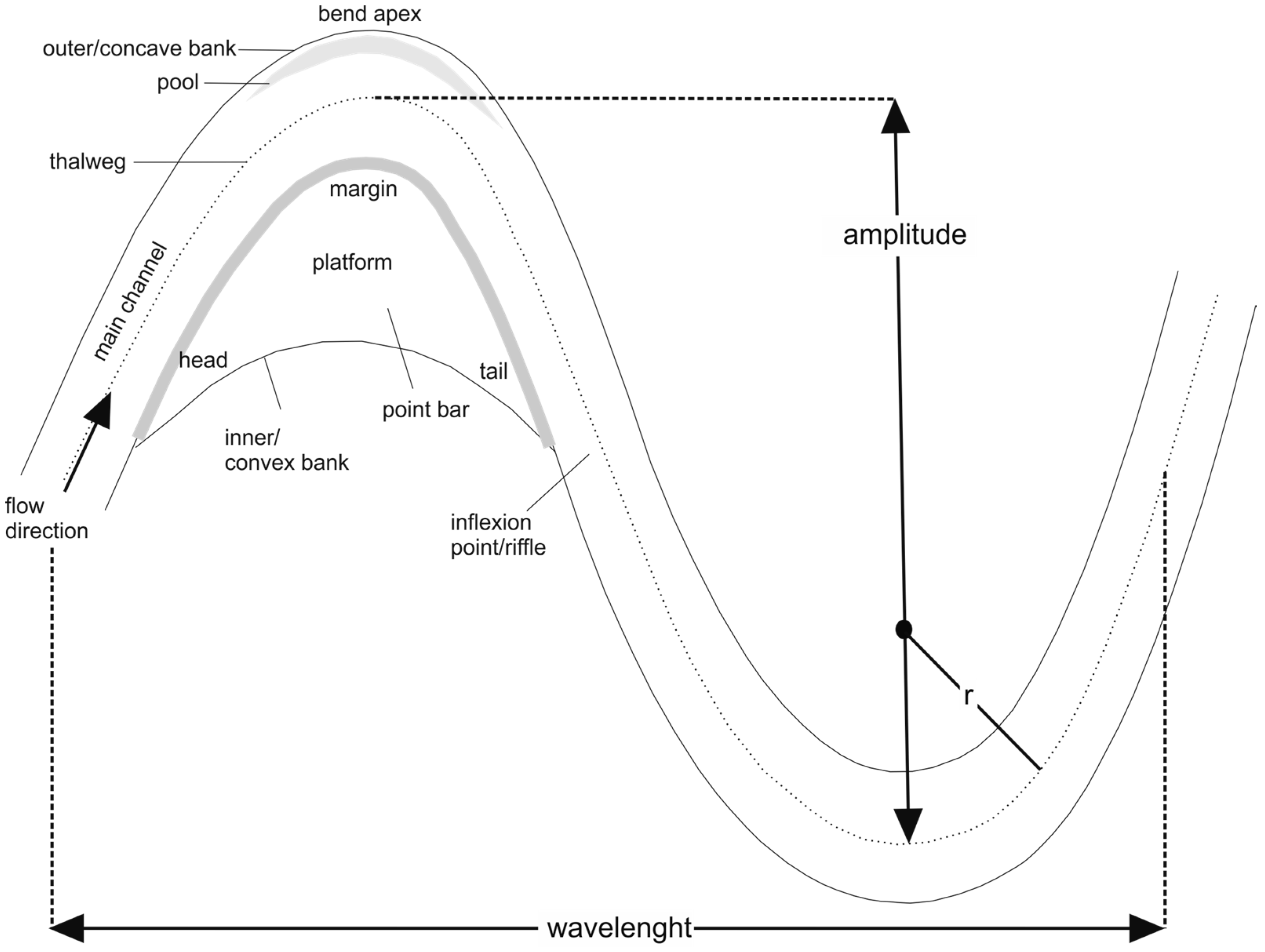
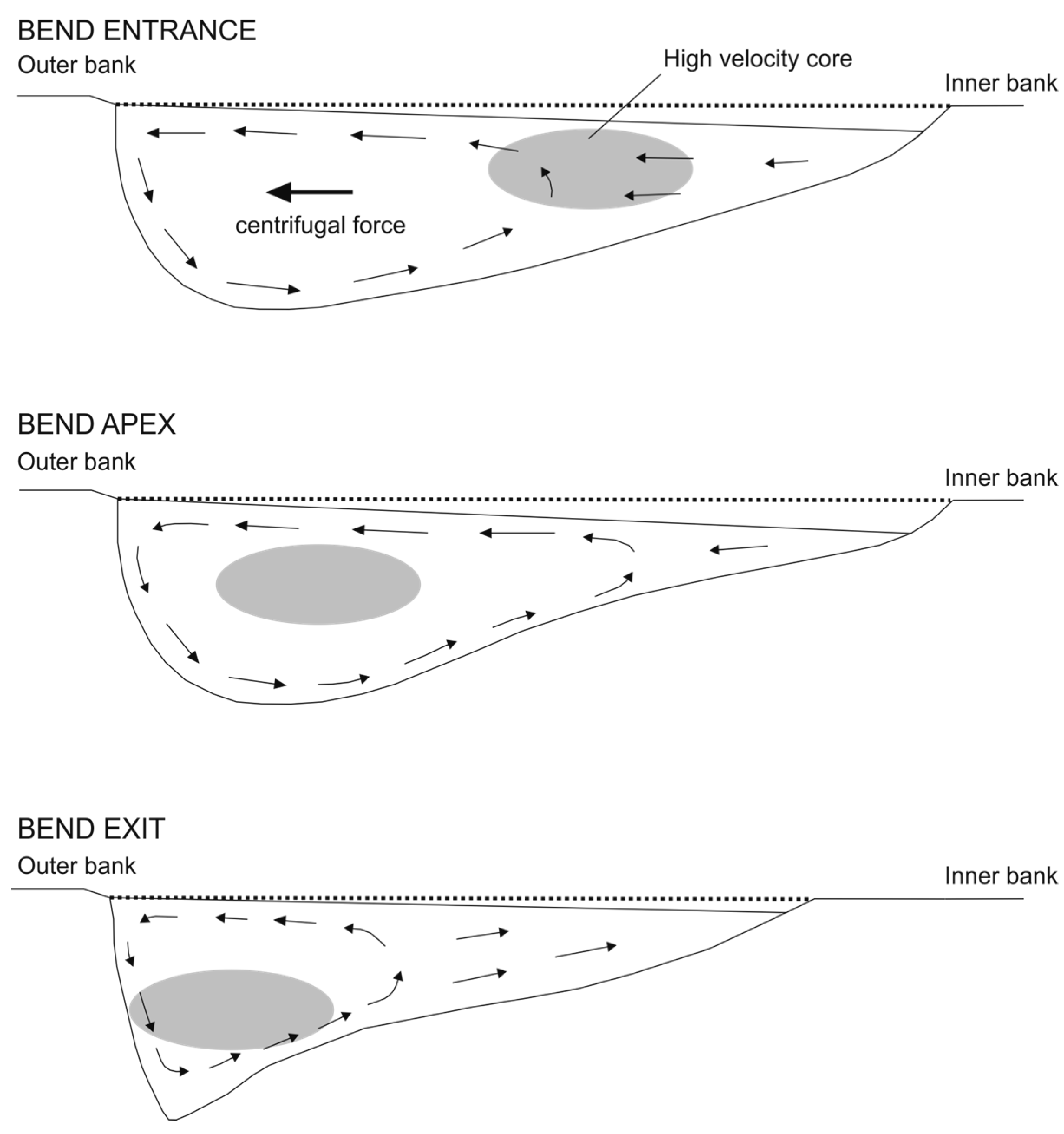
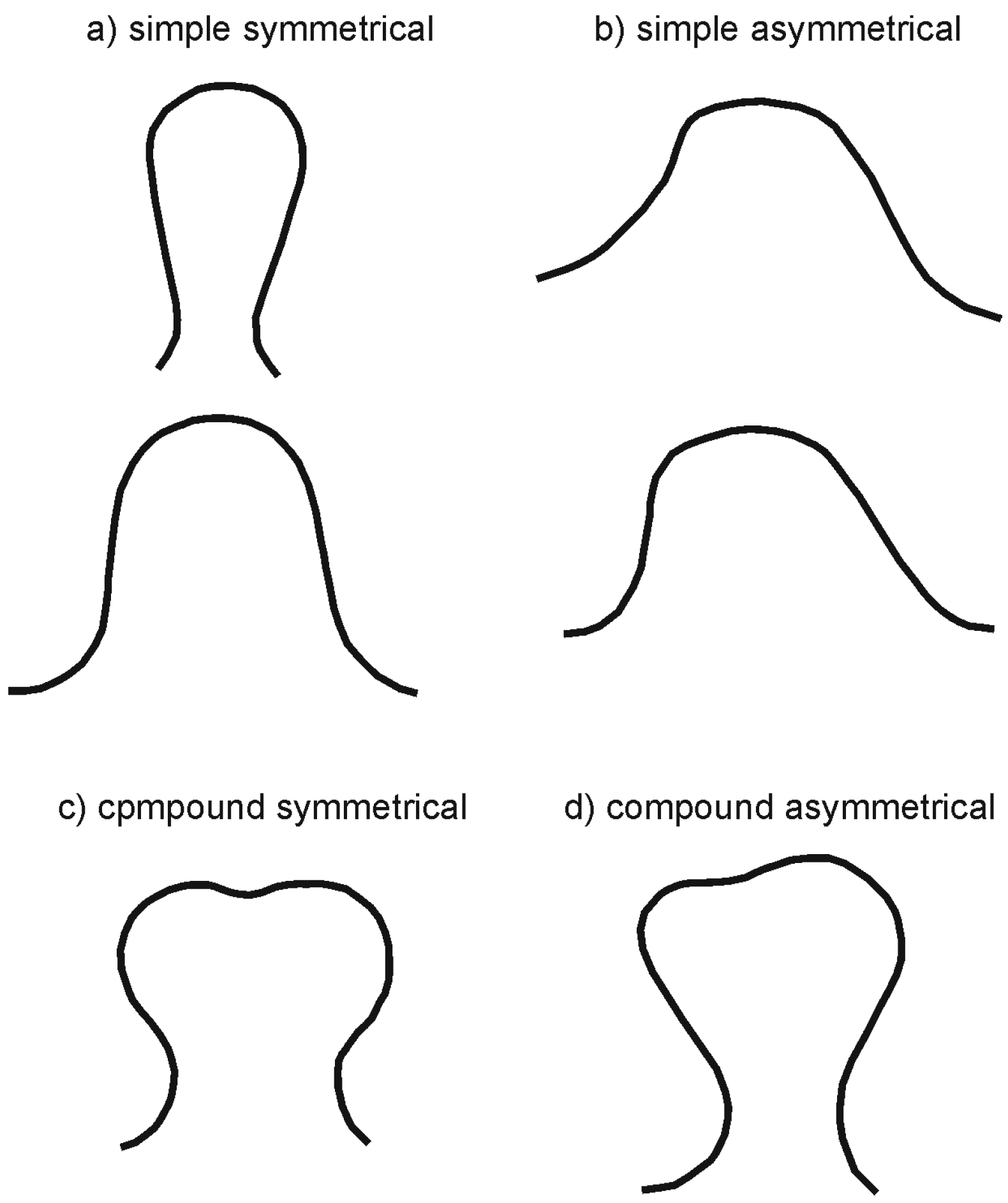
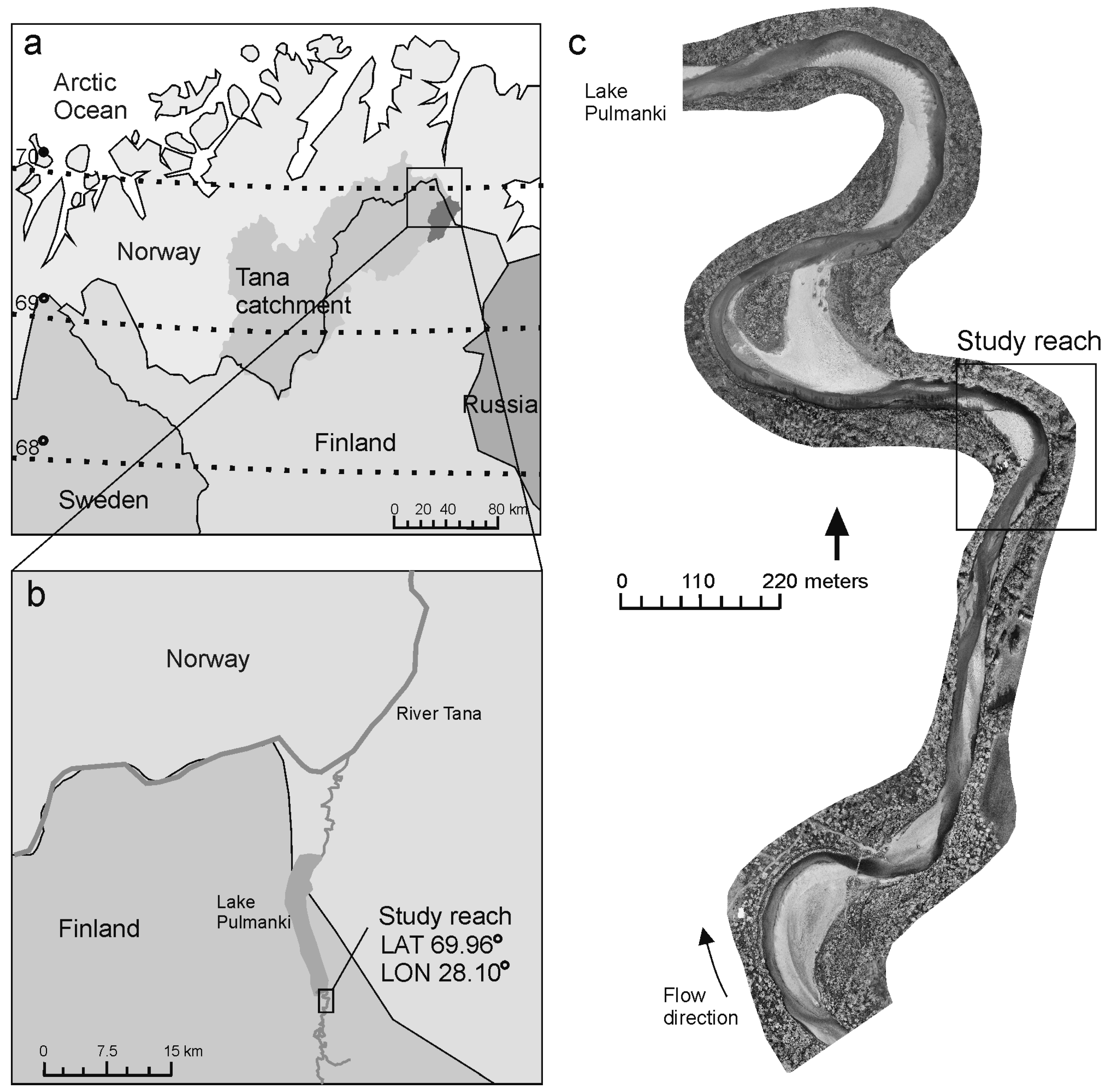
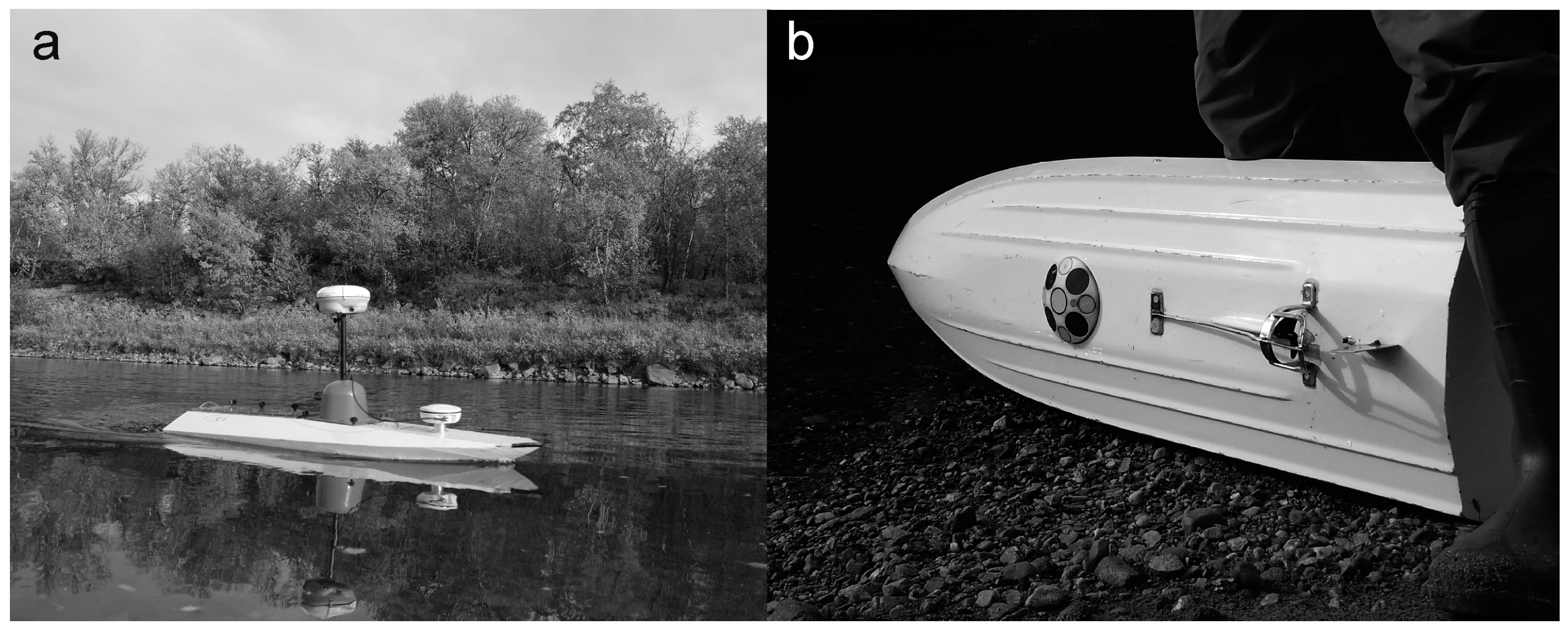
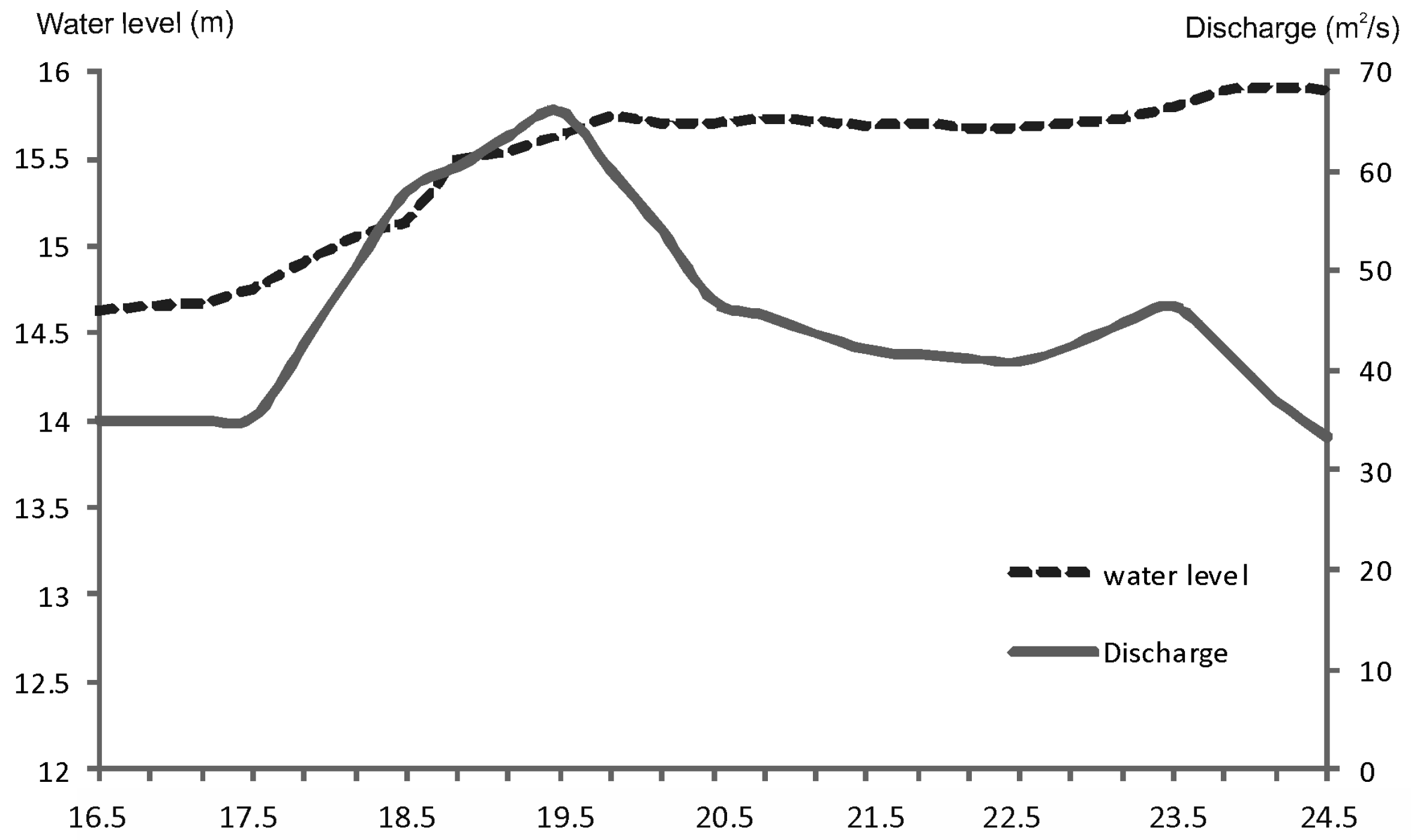
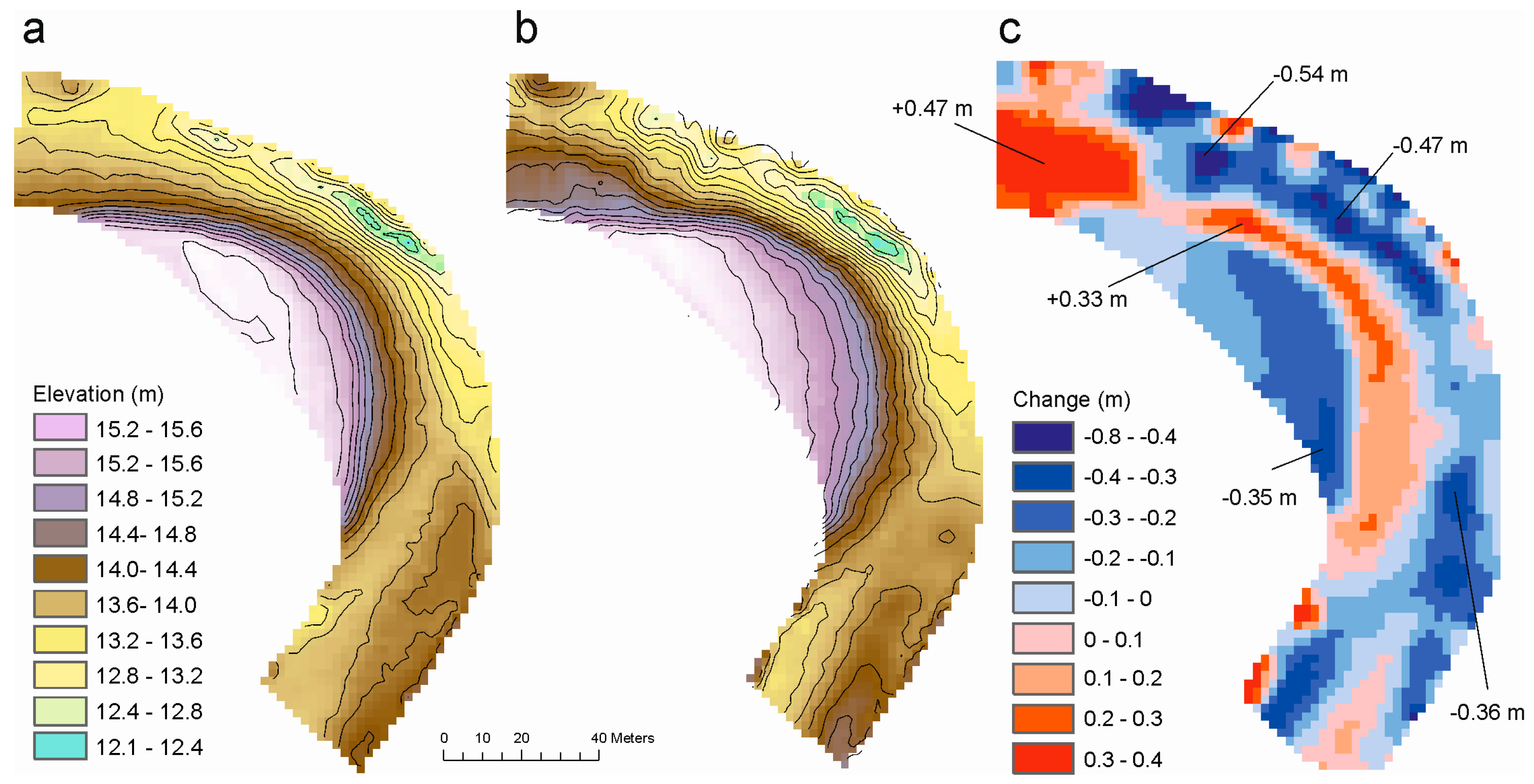
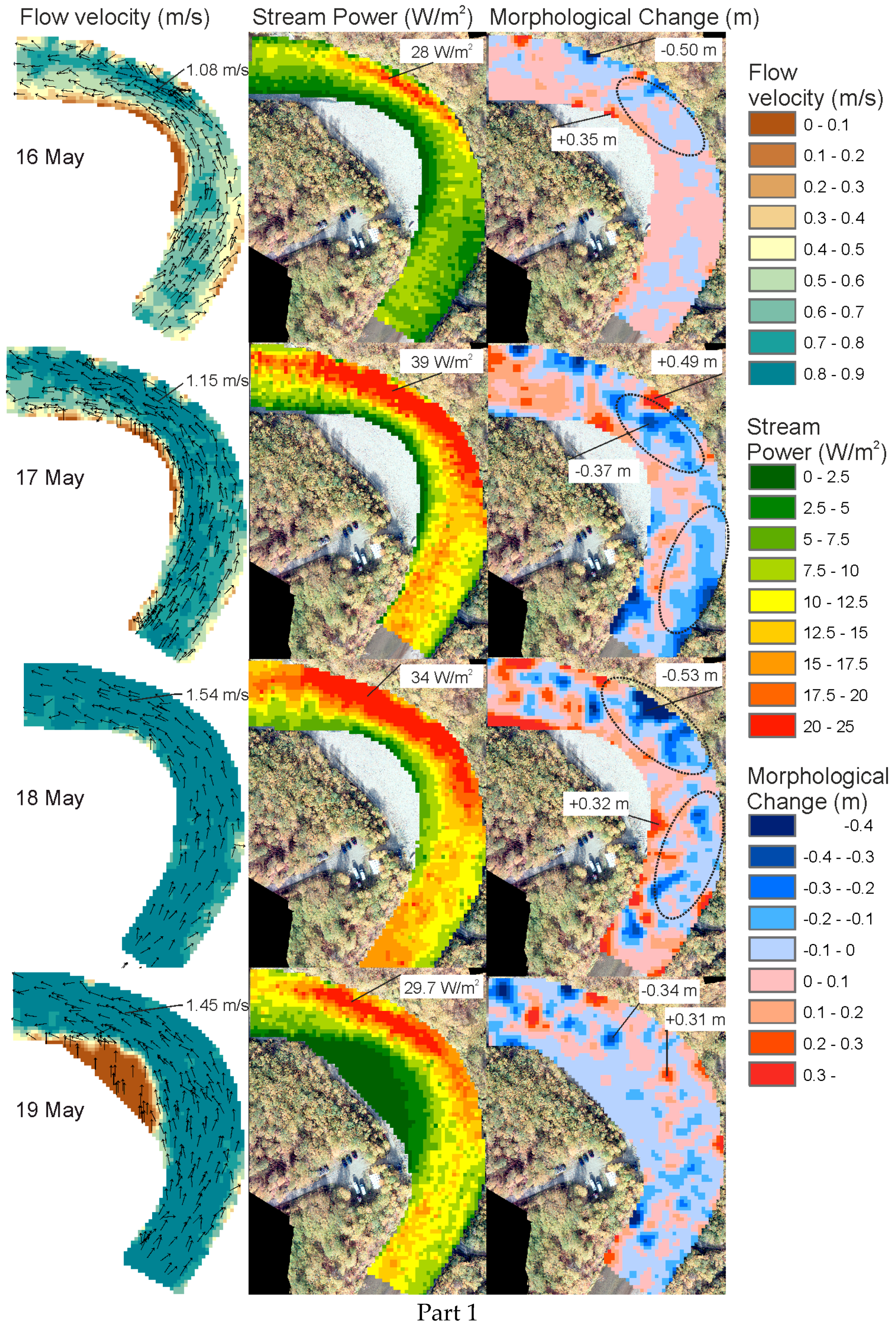
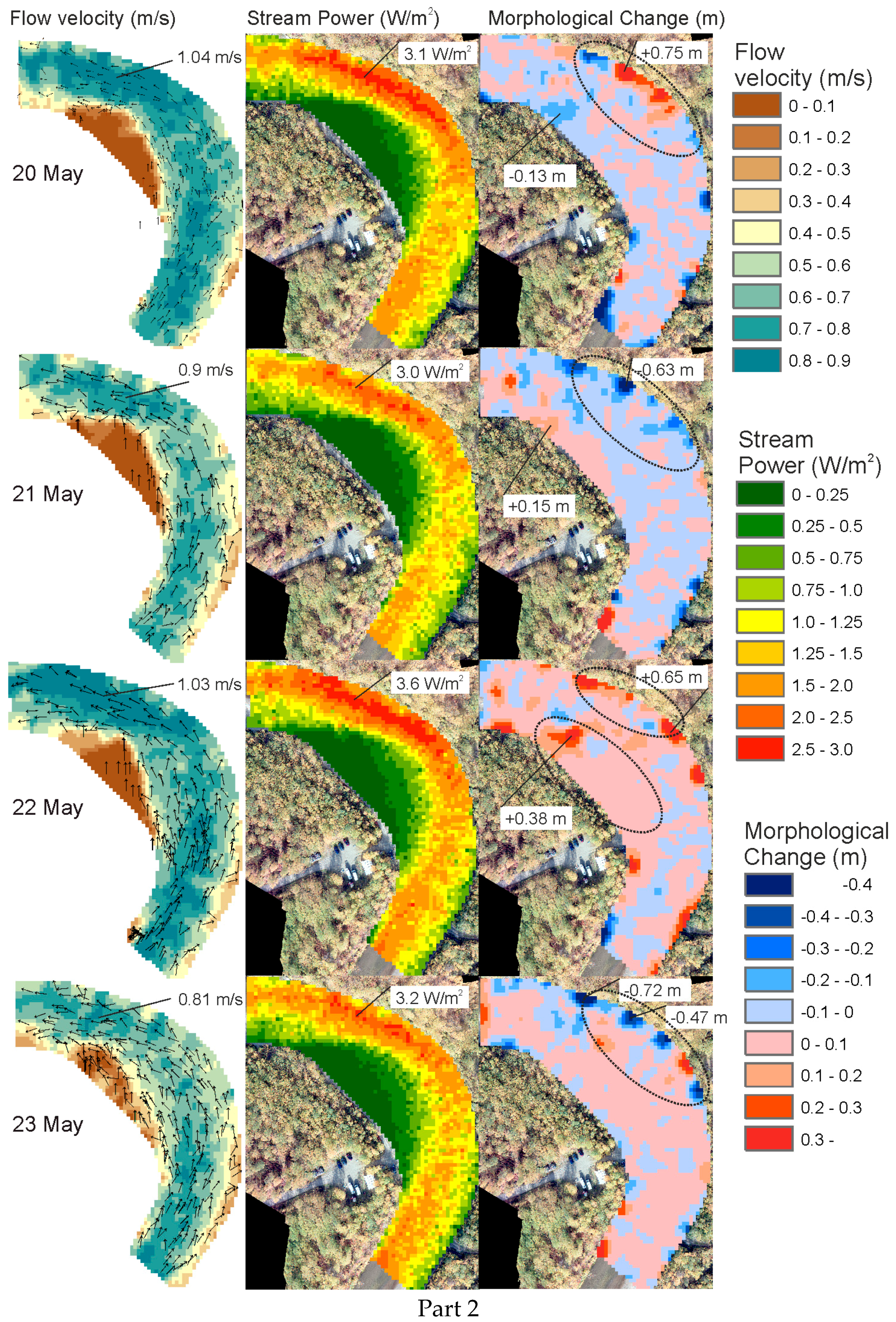
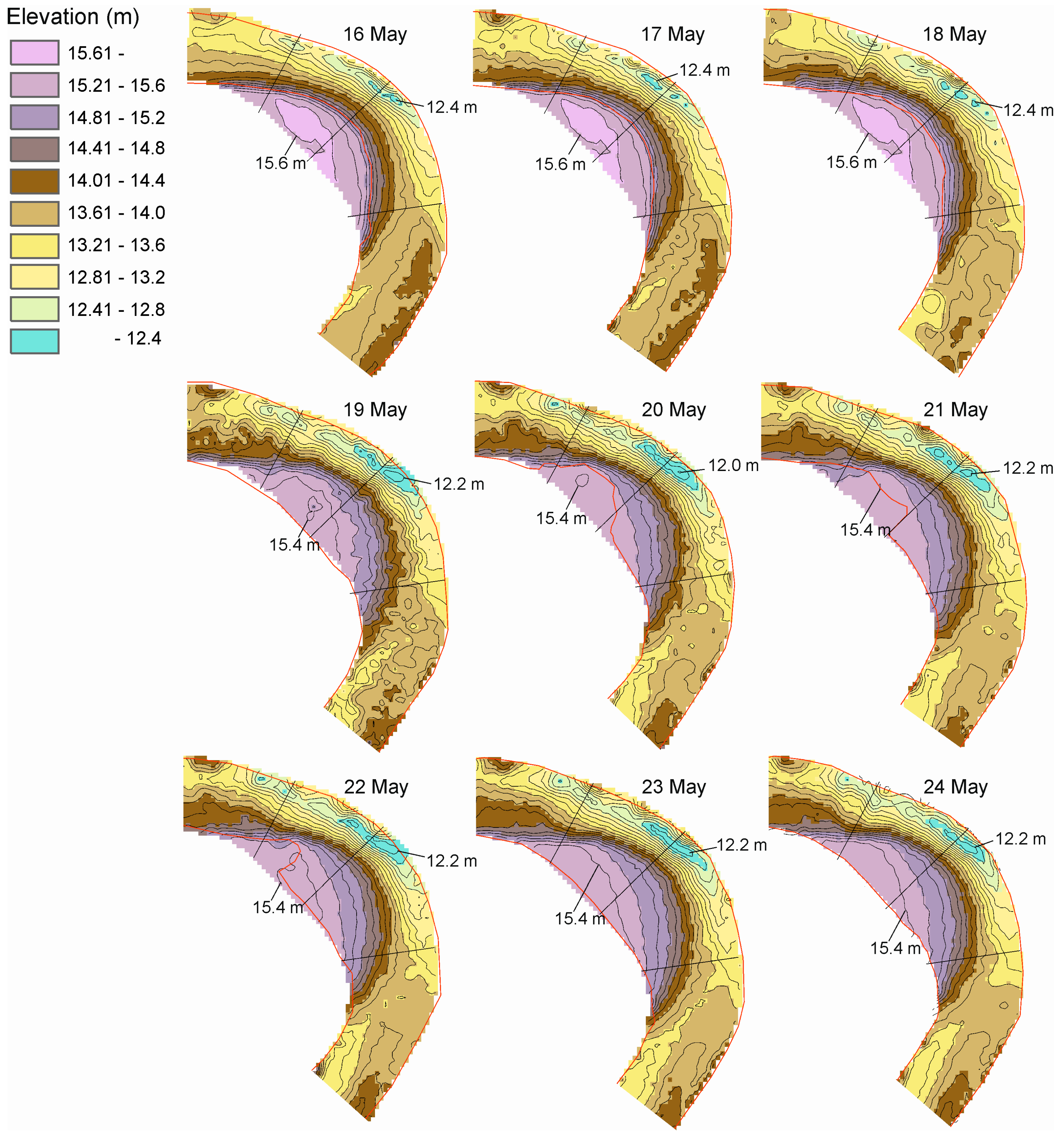
| Year | Q |
|---|---|
| 2009 | 42 |
| 2010 | 49 |
| 2011 | 25 |
| 2012 | 39 |
| 2013 | 67 |
| 2014 | 43 |
| 2015 | 30 |
| 2016 | 15 |
| 18 May | 22 May | |||||
|---|---|---|---|---|---|---|
| All Data | Deposition | Erosion | All Data | Deposition | Erosion | |
| stream power | −0.361 ** | −0.122 ** | 0.206 ** | −0.082 ** | 0.005 | −0.114 ** |
| n-b velocity | −0.297 ** | −0.145 ** | 0.243 ** | −0.124 ** | −0.062 * | −0.134 ** |
© 2017 by the authors. Licensee MDPI, Basel, Switzerland. This article is an open access article distributed under the terms and conditions of the Creative Commons Attribution (CC BY) license ( http://creativecommons.org/licenses/by/4.0/).
Share and Cite
Kasvi, E.; Laamanen, L.; Lotsari, E.; Alho, P. Flow Patterns and Morphological Changes in a Sandy Meander Bend during a Flood—Spatially and Temporally Intensive ADCP Measurement Approach. Water 2017, 9, 106. https://doi.org/10.3390/w9020106
Kasvi E, Laamanen L, Lotsari E, Alho P. Flow Patterns and Morphological Changes in a Sandy Meander Bend during a Flood—Spatially and Temporally Intensive ADCP Measurement Approach. Water. 2017; 9(2):106. https://doi.org/10.3390/w9020106
Chicago/Turabian StyleKasvi, Elina, Leena Laamanen, Eliisa Lotsari, and Petteri Alho. 2017. "Flow Patterns and Morphological Changes in a Sandy Meander Bend during a Flood—Spatially and Temporally Intensive ADCP Measurement Approach" Water 9, no. 2: 106. https://doi.org/10.3390/w9020106
APA StyleKasvi, E., Laamanen, L., Lotsari, E., & Alho, P. (2017). Flow Patterns and Morphological Changes in a Sandy Meander Bend during a Flood—Spatially and Temporally Intensive ADCP Measurement Approach. Water, 9(2), 106. https://doi.org/10.3390/w9020106






